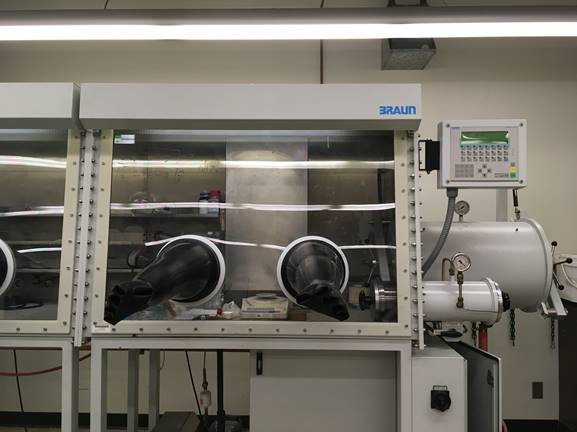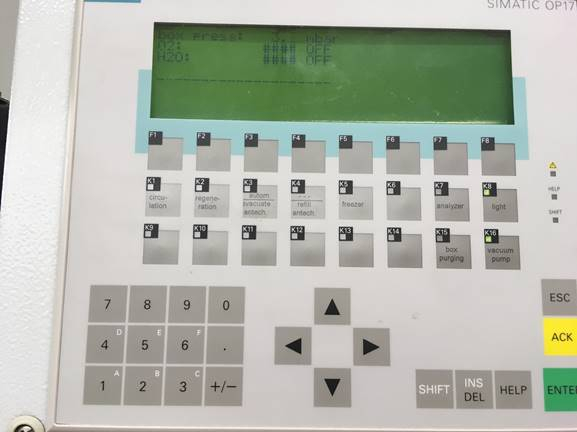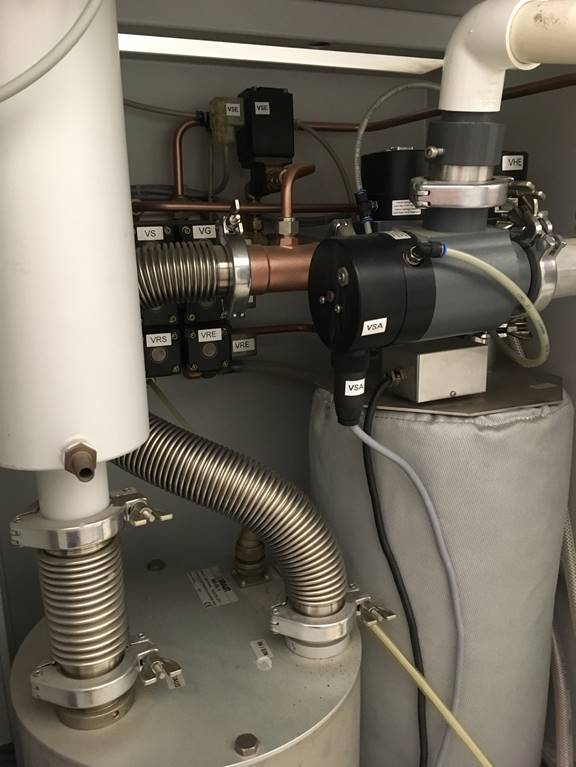Glovebox and Impurity Sensors
Overview
Source: Tamara M. Powers, Department of Chemistry, Texas A&M University
The glovebox provides a straightforward means to handle air- and moisture-sensitive solids and liquids. The glovebox is what it sounds like: a box with gloves attached to one or more sides, which allows the user to perform manipulations within the glovebox under an inert atmosphere.
For manipulations under inert atmospheres, chemists can choose between Schlenk or high-vacuum techniques and a glovebox. Schlenk and particularly high-vacuum techniques offer a higher degree of control of the atmosphere, and are thus suitable for reactions that are greatly air- and moisture-sensitive. The glovebox, however, provides greater access for manipulations in an inert atmosphere. Weighing out reagents, filtering reactions, preparing samples for spectroscopy, and growing crystals are all examples of routine procedures that are more readily performed in a glovebox versus a Schlenk/vacuum manifold. Advancements in glovebox design have increased its performance, such as running reactions at reduced temperatures and spectroscopy within the glovebox.
This video will demonstrate how to bring items in and out of the glovebox and how to qualitatively ensure a good working environment. Basic manipulations within a glovebox will be demonstrated through the synthesis of sodium benzophenone.
Principles
The glovebox allows for manipulation of air- and moisture-sensitive reagents and reactions in a similar manner as those performed on the benchtop. This is achieved by maintaining an inert atmosphere in the glovebox (< 1 ppm oxygen and moisture), and the user carrying out manipulations through gloves on the side of the glovebox. The inert gas is typically nitrogen, though argon and even helium may be used. A single glovebox has room for one user, or two gloves. Two users can work side-by-side in a double glovebox, which has four gloves in total. Each glovebox will have slightly different configurations and controls, depending on the manufacturing company. The principles discussed herein can be applied to most standard gloveboxes.
The Main Chamber:
The main chamber of the glovebox is comprised of a metal box (usually stainless steel) with polycarbonate windows on one or more sides of the box (Figure 1). Butyl gloves are fitted to the windows, allowing for manipulation inside the glovebox by external users. The box is constructed to be gas-tight, maximizing the integrity of the gas atmosphere within the box. Typically, it is run at a positive pressure, so the gloves stick out of the box. However, when working with extremely toxic or radioactive materials, the box may be run at a negative pressure as to minimize exposure risks.

Figure 1. The glovebox, showing the main chamber, the gloves, the control panel, and the large/small antechambers. The gloves stick out when it is run at positive pressure.
The pressure within is glovebox is generally maintained between ~ 3 and 6 mbar above atmospheric pressure and is regulated via electronics (Figure 2). The user can have additional control by raising or lowering the pressure via a footswitch. The pressure is increased by flowing more gas into the system, and decreased via evacuation from the vacuum pump.

Figure 2. The control panel controls the pressure, circulation, purge, light, regeneration, and the large antechamber.
Modern boxes are often fit with electrical feedthroughs, and so spectroscopy can be run in the box without having to bring the spectrometer into the box. Coldwells and freezers allow for reactions and storage of chemicals at reduced temperatures, respectively. Gas and vacuum hookups are also possible for the addition of secondary gases to experiments and the removal of solvents from reactions, respectively.
A source of contamination is from the solvents, reagents, and materials brought into the box. If solvents are not properly degassed and dried, then they can add moisture and oxygen to the glovebox atmosphere. Furthermore, they can react with and ruin the catalyst used to keep the atmosphere inert. Likewise, porous materials such as paper must be properly dried and allowed to fully outgas in the antechamber to minimize contamination.
The gloves are a major source of contamination. Because they are porous, air will flow into the glovebox, even when at a positive pressure. The rate of contamination will depend on both the glove material and thickness; typical values for a single glovebox (box with two gloves) are increases in impurities by 59 ppm/h when in use.1 This of course assumes that the atmosphere within the box is not continuously being purified or replaced. Because users generate heat and sweat, the contamination rate can increase to 500 ppm/h when the box is in use. Moreover, holes in the gloves will greatly increase the exchange of air with inert gas within the box.
To maintain a good environment, it is thus essential to have a method to keep the atmosphere within the box clean!
The Circulator, Catalyst, and Purging:
To maintain the inert atmosphere, the inert gas (most commonly nitrogen) is circulated from the main chamber to a catalyst, and back to the main chamber. The catalyst (Figure 3) is comprised of molecular sieves and a copper-containing catalyst. The molecular sieves adsorb water and solvent from the gas, while the copper catalyst reacts with oxygen. The two components work together to maintain an inert atmosphere that is free of moisture and oxygen. Large gloveboxes often have a fan in the middle of the chamber to help circulate the gas within the chamber. Gas-flow through the catalyst is done with the circulator. At the inlet and outlet of the chamber are filters, to minimize contamination via small particles.

Figure 3. The catalyst container is connected to the main chamber by two valves, which allows the atmosphere to circulate through the catalyst bed.
Over time, the catalyst of the glovebox becomes deactivated (the sieves become saturated with moisture/solvent, and/or the copper catalyst becomes inactive), and needs to be regenerated to maintain low levels or moisture and oxygen. This is done by regenerating the catalyst by heating it under a stream of hydrogen, stabilized by nitrogen (forming gas). The hydrogen serves to remove all solvent and water from the sieves, and to reduce the copper catalyst, that in the process releases water. The water and released solvent are removed via a vacuum pump.
The copper catalyst can be poisoned by certain solvents and volatile chemicals, and thus it is critical to minimize exposure to these impurities. This includes ether solvents, amines (temporary poison), halogens, alcohols, and sulfur-containing compounds (permanent poisons). The presence of the molecular sieves in the catalyst greatly reduces exposure of the copper catalyst to these chemicals, but over time, the copper may become deactivated, and the entire catalyst bed-sieves and copper-must be replaced.
To minimize contamination of the catalyst with undesirable chemicals, the main glovebox chamber can be isolated from the catalyst (by turning off circulation of the atmosphere through the catalyst) when chemicals are being used. The glovebox chamber can be purged (in essence replacing the atmosphere with a fresh supply of gas) before turning the circulation back on. This also ensures that the glovebox atmosphere does not contain trace solvents, which can impact chemical reactions or appear in NMR spectra when samples are prepared inside the glovebox. The length of the purge depends on how much of the inert atmosphere needs to be replaced. For instance, after ~ 5x the volume of the glovebox has been displaced by fresh gas, ~ 1% of the old inert gas remains; this decreases to 0.1% with 7x the volume change.1 The time will be determined by the flow rate of the inert gas into the chamber.
The Antechamber:
Chemicals and supplies are brought in and out of the glovebox via the antechamber (Figure 4). This is a sealed compartment that connects the glovebox to the outside, and can be evacuated with a vacuum pump and re-filled with inert atmosphere. To minimize contamination by air, users will typically run 3 cycles of purge/fill, with the time of evacuation depending on the size of the antechamber as well as what items are to be brought into the glovebox. Items that have a high surface area and are porous must be evacuated for a longer time, to ensure displacement of air.

Figure 4. The large and small antechambers; each have their own pressure gauge and valve.
In general, the fraction of air remaining in the chamber after each cycle of pumping and filling is given by Equation 1,1 where Af = fraction of air remaining, f is the vacuum pressure attainable (in atmospheres), and n is the number of cycles.
Af = fn (1)
Thus, after 2 cycles, a pump that can achieve 1 torr (1.3 x 10-3 atm) will have 1.7 ppm air (in inert gas). This number drops to 2.2 ppb air (in inert gas) after 3 cycles.
The time it takes to evacuate the chamber will depend on the chamber volume and pumping speed. This can be approximated by Equation 2,1 where t is time (min), V is volume of the chamber (L), S is the pumping speed of the vacuum (L/min), and P1 and P2 are the initial and final pressures, respectively.
 (2)
(2)
While older boxes have manual valves to open and close the vacuum/inert gas inlet to the chambers, modern boxes make use of electronic controls, and the process can even be automated.
Sensors and Controls:
Many modern gloveboxes make use of an electronic display and touchpad to control the gloveboxes (Figure 2). For instance, turning the circulator on and off, purging, opening and shutting valves on the antechamber, etc., are easily applied with the push of a button. The display can also monitor levels of oxygen and moisture in the glovebox, if sensors are installed, which greatly facilitates ensuring an inert environment. However, chemical sensors can likewise be used. Diethylzinc will smoke in the low ppm range of oxygen, and forms a white residue in the presence of water. Sodium benzophenone and the Ti(III) metallocene synthesized in the Schlenk Line module are also common indicators in the glovebox to ensure that the atmosphere is free of moisture and oxygen. Sodium benzophenone can also be used to ensure the removal of moisture from solvent. This purple radical indicator turns blue then colorless in the presence of moisture or oxygen.
Procedure
1. Bringing Items into the Glovebox
- Make sure that the item(s) to be brought in have been oven-dried (if glassware), and that containers are open.
- Check the antechamber log to ensure that it is empty.
- Fill the antechamber, either manually or electronically. Once filled with 1 atm of inert gas, close the inlet valve to isolate the chamber.
- Open the antechamber to the outside, and place the items in the chamber.
- Close the chamber, and evacuate (manually or electronically).
- Fill in the log. Typically, users include their initials, items, and times of each cycle.
- After the pressure dial reaches the minimum pressure, leave the antechamber under dynamic vacuum for 5 min for a small antechamber, and 20 min for a large antechamber.
- Refill the antechamber with inert gas; typically, users will backfill to ~ 0.75 atm, as the inlet valve connects the main chamber to the antechamber.
- Evacuate, and note the time.
- Repeat steps 1.8-1.9, so that in total the antechamber has been evacuated 3x.
- After 3 cycles, fill the antechamber with inert gas, and close off the insert gas supply.
- Open the antechamber from inside the glovebox, and bring the items into the antechamber.
- Close the antechamber door, and evacuate the chamber. When the glovebox is in its resting state, the chambers should be left under dynamic vacuum.
- Note on the log that the procedure is complete, so that other users know that the antechamber is free.
2. Removing Items from the Glovebox
- Look at the logbook to see the status of the antechamber. Be sure that it is not in use, and that the last operation was to bring an item into the antechamber. If the last operation was to bring an item out, quickly fill/evacuate the antechamber 3x with inert gas. This is to ensure no residual air is present (Equation 1) when opening the antechamber to the glovebox.
- Fill the antechamber with inert gas, and close the valve connecting the inert gas supply to the chamber.
- Open the antechamber from the inside of the glovebox.
- Load the items into the chamber, and close the door.
- From the outside of the glovebox, open the antechamber door and remove the items.
- Evacuate the chamber.
- Note that items were removed and the time on the logbook.
3. Ensuring a Good Working Environment
- Testing the environment
- Turn off the circulator.
- Turn off any fans in the main glovebox chamber.
- Open a bottle of diethylzinc solution in hexanes (frequently 1.0 M).
- Gently swirl the bottle to replace the gas atmosphere in the bottle with the atmosphere in the box. If smoke emerges from the bottle, this is an indication that O2, water, or an ether solvent is present in the atmosphere. If the atmosphere is compromised, the source of unwanted impurities should be identified.
- Turn the purge on for 5 min.
- Turn the purge off and the circulator on.
- Making the radical indicator
- Turn off the circulator.
- In the glovebox, weigh out 5 mg of benzophenone and transfer this to a 20-mL scintillation vial.
- Weigh out ~ 500-1,000 mg of sodium and transfer this to the scintillation vial. Cap the vial.
- Add 20 mL of dry tetrahydrofuran (THF) and a stir bar. Cap the vial.
- Turn the purge on for at least 15 min before turning the circulator back on.
- Let the reaction stir for 48 h, or until the solution turns into a dark, inky purple solution. The solution should go from colorless to blue to purple, and there should be excess sodium at the bottom of the vial. This should give a solution with ~ 1.4 mM radical.
- Testing solvent with the di-radical indicator
Note: The newly synthesized radical can be used to test for O2 and water impurities in solvents.- If testing an ether solvent, turn the circulator off. Some groups require that the circulator is turned off before opening any chemical in the box.
- Add one drop of the radical solution to 10 mL of the test solvent. Solvents that can be tested using the radical include THF, diethyl ether, toluene, benzene, hexanes, and pentane. The radical will react with chlorinated solvents, pyridine, and other solvents that react with alkali metals.
- Observe the color of the solution over 1-2 min. A dry solvent will hold the color of the ketyl radical indefinitely. Realistically, the sample should hold the color for at least 1-2 min. Positive test colors are given in Table 1 below.
- Close all solvent bottles and turn the purge on for at least 15 min. Turn the circulator on again.
| Table 1. Positive test colors for solvent tests with radical. | |
| Solvent | Color |
| Diethyl ether | Dark blue |
| THF | Dark purple |
| Benzene/toluene/xylenes | Dark blue/purple |
| Hexanes/pentane | Dark blue |
Application and Summary
The glovebox is a very practical tool for working with and manipulating air- and moisture-sensitive compounds. Most manipulations that can be done on the benchtop, can be done readily in an inert atmosphere.
The glovebox can be used to store chemicals, carry out reactions, and run spectroscopic analysis. Gloveboxes are fully customizable, so customers can request many add-ons to meet their needs. Different laboratories will have different glovebox user guidelines; therefore, it is very important to understand the requirements for working in a glovebox before performing any manipulations.
References
- Shriver, M. A. Drezdzon. The Manipulation of Air-Sensitive Compounds. John Wiley & Sons. USA. (1986).
Tags
Skip to...
Videos from this collection:

Now Playing
Glovebox and Impurity Sensors
Inorganic Chemistry
18.6K Views

Synthesis Of A Ti(III) Metallocene Using Schlenk Line Technique
Inorganic Chemistry
31.5K Views

Purification of Ferrocene by Sublimation
Inorganic Chemistry
54.3K Views

The Evans Method
Inorganic Chemistry
67.9K Views

Single Crystal and Powder X-ray Diffraction
Inorganic Chemistry
103.9K Views

Electron Paramagnetic Resonance (EPR) Spectroscopy
Inorganic Chemistry
25.3K Views

Mössbauer Spectroscopy
Inorganic Chemistry
21.9K Views

Lewis Acid-Base Interaction in Ph3P-BH3
Inorganic Chemistry
38.7K Views

Structure Of Ferrocene
Inorganic Chemistry
79.1K Views

Application of Group Theory to IR Spectroscopy
Inorganic Chemistry
44.9K Views

Molecular Orbital (MO) Theory
Inorganic Chemistry
35.1K Views

Quadruply Metal-Metal Bonded Paddlewheels
Inorganic Chemistry
15.3K Views

Dye-sensitized Solar Cells
Inorganic Chemistry
15.7K Views

Synthesis of an Oxygen-Carrying Cobalt(II) Complex
Inorganic Chemistry
51.5K Views

Photochemical Initiation Of Radical Polymerization Reactions
Inorganic Chemistry
16.7K Views
Copyright © 2025 MyJoVE Corporation. All rights reserved